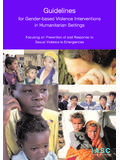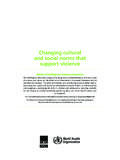Transcription of Conducting population-based research on gender-based ...
1 Conducting population-based research on gender-based violence in conflict-affected settings: an overview of a multi-country research project Expert paper prepared by: Jeanne Ward 1 IRIN (Consultant) " violence against women: a statistical overview , challenges and gaps in data collection and methodology and approaches for overcoming them" Expert Group Meeting Organized by: UN Division for the Advancement of Women in collaboration with: Economic Commission for Europe (ECE) and World Health Organization (WHO) 11 14 April, 2005 Geneva Switzerland pdfMachine by Broadgun Software - a great PDF writer! - a great PDF creator!
2 - There has been increasing concern in recent years among humanitarian aid organizations about the extent and effects of gender-based violence (GBV) in refugee, internally displaced and post-conflict settings. There has also been increasing recognition that GBV is an affront to public health, universally accepted human rights guarantees, and the restoration of refugee and internally displaced (IDP) families and communities. The list below illustrates women s and girls vulnerability to violence during and following some of the more recent of the world s conflicts. While war may be understood as a contributing factor, all these manifestations of GBV are essentially based on long-standing attitudes and behaviors that sustain and reinforce GBV, whether in times of peace or of 20,000 to 50,000 women were raped during the war in Bosnia and Herzegovina in the early 1990 s the vast majority of Tutsi women in Rwanda s 1994 genocide were likely exposed to some form of GBV.
3 Of those, it is estimated that a quarter to a half million survived rape approximately 50,000 to 64,000 internally displaced women in Sierra Leone have histories of war-related assault in a 1995 survey of post-conflict Nicaragua, 50 percent of female respondents had been beaten by a husband, and 30 percent had been forced to have sex 76 percent of prostitutes surveyed in post-genocide Rwanda in 1998 who had undergone HIV testing were seropositive percent of participants in a 1998 Sierra Leone survey on domestic violence had been beaten by an intimate partner according to a 1999 government survey, 37 percent of Sierra Leone s prostitutes were less than 15 years of age, and more than 80 percent were unaccompanied or displaced children an estimated forty thousand Burmese women are trafficked each year into Thailand s factories, brothels, and as domestic workers findings from a study of Palestinian refugee women indicated of women were subjected to beating at least once during their marriage with the husband the main perpetrator and of children had been beaten at least once almost entirely by their parents.
4 25 percent of Azeri women surveyed in 2000 by the Center s for Disease Control acknowledged being forced to have sex: those at greatest risk were among Azerbaijan s internally displaced, 23 percent of whom acknowledged being beaten by a husband. Darfur is yet another setting where history repeats itself, and where, once again, the failure to stem the explosively high incidents of GBV will have far-reaching consequences to the survivors and their families, as well as to the communities in which it is occurring. RHRC Consortium GBV Initiative 1 This summary was published in abbreviated form in an article in Forced Migration Review 2004 19 (1) 2 The statistics cited are taken from the RHRC Consortium s fact sheet on GBV, available at From 2000-2004 the Reproductive Health Response in Conflict (RHRC) Consortium spearheaded a global GBV Initiative.
5 The Initiative was jointly administered by the Women s Commission for Refugee Women and Children and the International Rescue Committee, and funded by the State Department s Bureau of Population, Refugees, and Migration (BPRM). The first major outcome of the Initiative was a qualitative assessment of GBV in conflict settings: If not now, when?: Addressing GBV in refugee, internally displaced, and post-conflict settings (2002). One of the primary findings of the global overview was that scant data are available about the prevalence of GBV or best practices for qualitatively or quantitatively describing the problem. Without sufficient quantitative, qualitative, or service delivery data, many humanitarian agencies lack the knowledge or the tools to comprehensively address GBV in the populations they serve.
6 In an effort to improve international capacity to measure, prevent, and respond to GBV among refugees, IDPs, and other conflict-affected populations, the GBV Initiative undertook the design of a gender-based violence Tools Manual for Assessment and Program Design, Monitoring, and Evaluation (2004). In addition to a series of qualitative assessment tools and techniques, the GBV Tools Manual contains a working draft of a standardized population-based survey designed to measure multiple forms of GBV in conflict-affected settings around the world. Field-tested in East Timor and Kosovo, the questionnaire was subsequently used to conduct a national survey in Rwanda as well as research among IDP women and girls in Colombia.
7 The questionnaire is the first of its kind to have been applied in Africa, Asia, Europe, and Latin America. A primary objective of each of the four studies was to generate reliable prevalence data for locally-based programs to use in their GBV-related program planning and advocacy activities. A second objective of the research was to promote local capacity to conduct population-based research , so that local partners could obtain the tools (such as a validated questionnaire in the local language) and basic skills necessary to design follow-on research projects. An additional outcome will be the ability to use the data as part of a multi-country review of GBV in conflict-affected settings.
8 The methodology for Conducting the research was primarily informed by standards promoted by the World Heath Organization that seek to minimize harm and maximize benefits to GBV research participants and target communities. The field tests and subsequent surveys in Rwanda and Colombia resulted in a refinement of the questionnaire, as well as a refinement of the methodology for Conducting GBV research in conflict-affected settings. A general overview of the questionnaire and research process is provided below. Survey Questionnaire The questionnaire was created for humanitarian settings by researchers at the University of Arizona College of Public Health, the Centers for Disease Control and Prevention (CDC), and the RHRC.
9 It was designed to generate estimates of sexual and physical violence perpetrated by armed actors and other non-family members during time periods defined by historical markers including conflict, displacement, and post-conflict. It was also designed to investigate recent incidence of intimate partner violence and lifetime prevalence of injuries. Questions were incorporated to elicit contextual information about the violence , including the types of injuries sustained, pregnancy outcomes, whether and what sources of help were consulted and their comparative value, and emotional health status. Other questions targeted exposure to family violence in childhood as well as forced abduction related to conflict.
10 To facilitate comparability with existing questionnaires and benefit from the efforts of previous investigators, questions were taken whenever possible from preexisting surveys, editing or adding response options to tailor them to conflict settings. However, it was generally not possible to use validated sexual violence questions, as this subject remains under-investigated globally. The survey consisted of items from the World Health Organization, Demographic and Health Survey (DHS), the CDC Reproductive Health Surveys, the International Rescue Committee (IRC), Physicians for Human Rights, the Impact of Events Scale, and the Hopkins Symptom Checklist.













